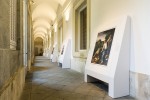 In 2012 I blogged about the Penn Museum’s pilot program of Touch Tours to give blind and visually impaired visitors the opportunity to explore select ancient artifacts by touch. It was an immense success and the next year was expanded to include even cooler elements like raised line diagrams, visually impaired assistant docents and the opportunity to smell mummification oils. Touch Tours are now an annual event at the Penn Museum.
In 2012 I blogged about the Penn Museum’s pilot program of Touch Tours to give blind and visually impaired visitors the opportunity to explore select ancient artifacts by touch. It was an immense success and the next year was expanded to include even cooler elements like raised line diagrams, visually impaired assistant docents and the opportunity to smell mummification oils. Touch Tours are now an annual event at the Penn Museum.
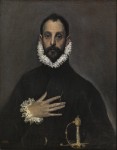 One of the reasons this was possible, despite the almost universal strictures against touching exhibits in museums worldwide, is that Penn Museum focused on stone artifacts with all kinds of textural and relief features from their ancient Egyptian collection. Visitors still had to meticulously clean their hands with sanitizer wipes before being allowed to explore the pieces, but granite and limestone and basalt can take a lot of touching without being damaged and their three-dimensional designs give the non-sighted rich details to explore. Paint, on the other hand, is highly susceptible to damage from our grubby paws, and paintings are two-dimensional. Even if visitors were allowed to put their oily, sweaty and oozy mitts on the art, touch can’t convey much of the painted image (unless it’s a Jackson Pollock).
One of the reasons this was possible, despite the almost universal strictures against touching exhibits in museums worldwide, is that Penn Museum focused on stone artifacts with all kinds of textural and relief features from their ancient Egyptian collection. Visitors still had to meticulously clean their hands with sanitizer wipes before being allowed to explore the pieces, but granite and limestone and basalt can take a lot of touching without being damaged and their three-dimensional designs give the non-sighted rich details to explore. Paint, on the other hand, is highly susceptible to damage from our grubby paws, and paintings are two-dimensional. Even if visitors were allowed to put their oily, sweaty and oozy mitts on the art, touch can’t convey much of the painted image (unless it’s a Jackson Pollock).
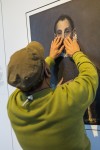 The Prado has overcome those challenges with a brilliant idea: relief reproductions of select artworks. The project began a year ago when the museum commissioned the innovative Basque graphics company Estudios Durero to create relief images that would allow blind and low-vision visitors to explore paintings from the Prado’s collection with their hands. Because many visually impaired people can still see color but standard 3D printing hasn’t yet gotten to the point of being able to recreate accurately the vast range of colors in a painting, Estudios Durero used a proprietary technique they’ve developed called Didú which uses a high resolution image of the work printed in special ink as the base. The areas that need to be in relief are marked and a chemical is added to them which makes the ink develop volume and texture up to six millimeters deep. The image of the painting with accurate colors is then printed onto that base.
The Prado has overcome those challenges with a brilliant idea: relief reproductions of select artworks. The project began a year ago when the museum commissioned the innovative Basque graphics company Estudios Durero to create relief images that would allow blind and low-vision visitors to explore paintings from the Prado’s collection with their hands. Because many visually impaired people can still see color but standard 3D printing hasn’t yet gotten to the point of being able to recreate accurately the vast range of colors in a painting, Estudios Durero used a proprietary technique they’ve developed called Didú which uses a high resolution image of the work printed in special ink as the base. The areas that need to be in relief are marked and a chemical is added to them which makes the ink develop volume and texture up to six millimeters deep. The image of the painting with accurate colors is then printed onto that base.
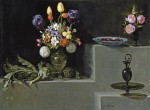 Museum curators worked with the Estudios Durero team to pick the paintings best suited to this kind of exploration. Extremely detailed pieces would be too hard to follow, and the scale of the paintings had to be manageable both for the printing process and for the visitors to be able to reach every part of them. Blind and low-sighted consultants were enlisted to help the team figure out which parts of the painting should be highlighted in relief. The eyes, it turned out, worked better as concave elements rather than convex because the holes provided a reference point for the visually impaired to orient themselves as they explored the artwork.
Museum curators worked with the Estudios Durero team to pick the paintings best suited to this kind of exploration. Extremely detailed pieces would be too hard to follow, and the scale of the paintings had to be manageable both for the printing process and for the visitors to be able to reach every part of them. Blind and low-sighted consultants were enlisted to help the team figure out which parts of the painting should be highlighted in relief. The eyes, it turned out, worked better as concave elements rather than convex because the holes provided a reference point for the visually impaired to orient themselves as they explored the artwork.
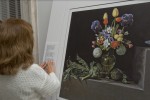 Six works were chosen for this exhibition: Noli me tangere (ca. 1525) by Correggio, Vulcan’s Forge (1630) by Velázquez, The Parasol (1777) by Goya, Mona Lisa (1503-1519) from the workshop of Leonardo da Vinci, The Nobleman with his Hand on his Chest (ca. 1580) by El Greco and Still life with Artichokes, Flowers and Glass Vessels (1627) by Juan van der Hamen. That copy of the Mona Lisa, by the way, is the one which was painted contemporaneously with the original
Six works were chosen for this exhibition: Noli me tangere (ca. 1525) by Correggio, Vulcan’s Forge (1630) by Velázquez, The Parasol (1777) by Goya, Mona Lisa (1503-1519) from the workshop of Leonardo da Vinci, The Nobleman with his Hand on his Chest (ca. 1580) by El Greco and Still life with Artichokes, Flowers and Glass Vessels (1627) by Juan van der Hamen. That copy of the Mona Lisa, by the way, is the one which was painted contemporaneously with the original 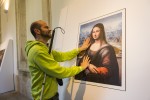 and has details that on the original are obscured by thick, darkened varnish. In addition to the paintings, the exhibition features new explanatory materials created specifically to convey information to the non and low-sighted on braille panels next to the works and in audio tours. The museum also provides opaque glasses for sighted visitors to experience the paintings by touch the way the visually impaired do.
and has details that on the original are obscured by thick, darkened varnish. In addition to the paintings, the exhibition features new explanatory materials created specifically to convey information to the non and low-sighted on braille panels next to the works and in audio tours. The museum also provides opaque glasses for sighted visitors to experience the paintings by touch the way the visually impaired do.
Touching the Prado opened January 19th and runs through June 28th. The exhibition has been a smashing success so far and it’s only in its infancy. The museum is planning on expanding the exhibition with additional paintings. Estudios Durero is working on finding new ways to convey the sensory experience of skin, hair, textiles, metal, glass, all kinds of materials represented in the paintings. Other museums have contacted them about setting up similar programs, so this could small project could have far-reaching consequences in making the visual arts accessible to those who have been all but cut off from them.
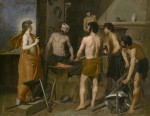
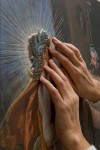
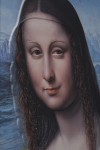
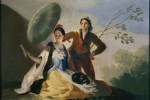
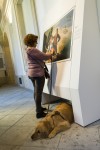
Wonderful idea! (I had to smile at the selection of Noli me tangere, as it means “touch me not”!)
Yes! I can’t help but think that was intentional.
That is SO COOL.
Hell yes. :yes:
This is wonderful! Amazing! The video brought tears to my eyes!
I found it tremendously moving too.
The idea is far from being new.
I saw something like that in some italian museums 25 years ago.
It doesn’t work.
These installations are going to become useless, dusty, dirty encumbrance very soon.
I don’t think 3D printing was an option 25 years ago. In any case, if the exhibitions prove to be unsuccessful, the museums can simply give the reproductions away. I’m sure there are plenty of schools or children’s museums that would we glad to receive them. It’s not like they built a new facility to house them or anything.
Well this post made me very warmfuzzy